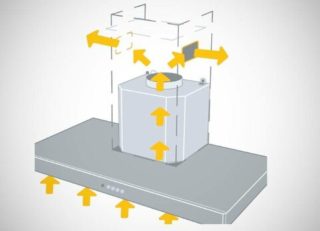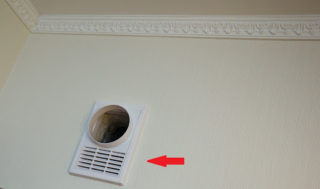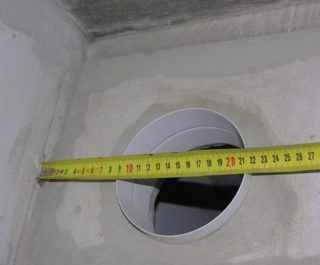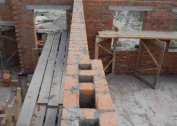Most users are skeptical about combining hoods and ventilation in the kitchen into one channel. By this they deprive themselves of the many advantages of their exploitation. If the ventilation duct serves one stove, the owner will not be able to connect to the natural system when the exhaust unit is turned off.
The need for ventilation in the kitchen
Natural ventilation in the kitchen with hood is necessary to maintain a comfortable and healthy microclimate in the apartment. In addition, it helps protect users from harmful fumes emitted during cooking. Hoods in the kitchen are usually not enough, which forces users to address the issue of its compatibility with natural ventilation.
The principle of operation of the latter is in the directional movement of air due to the pressure difference in the street and in the apartment. It is formed due to the temperature difference, which is maintained in homes for most of the year. The main disadvantage of this system is the instability associated with the variability of climatic conditions. As a result, apartment owners always have to check for traction. This is done in one of the proven ways.
In the first case, it is enough to take a sheet of paper and attach it to the kitchen ventilation hatch. If it immediately “sticks” to the hole, the system is operational and the pressure difference is maintained at a normal level. When a piece of paper slides along the wall, there is no draft — ventilation is not working or is very weak.
The second way to check is to bring a lighted candle, match or gas lighter to the hatch. With good traction, the flame deflects toward the vent.
If there are problems with the natural outflow of air, it will be necessary to clean the ventilation shafts and existing ducts, which forces you to seek help from specialists. Under certain conditions, inoperative ventilation can cause the draft to tip over. At the same time, air from the street will begin to flow into the apartment, completely blocking the operation of the hood.
Existing kitchen hood systems
Forced exhaust (ventilation) differs from the natural greater efficiency in the removal of contaminated air. According to the method of processing air masses, the models on the market are divided into two types:
- Units equipped with filtering elements passing through themselves the air discharged into the street.
- Exhaust devices operating on the principle of recycling (reuse).
In the first samples, the air after cleaning does not stay in the room and is taken out. Models of the second type contain built-in carbon filters, after passing through which the cleaned masses again return to the kitchen. To increase the ventilation efficiency, the location of the hood above the gas stove is important. This primarily concerns the height of its distance from the heating plane. According to regulatory requirements, this indicator for gas stoves should not be less than 75 cm. Such remoteness will protect the unit from thermal radiation and will not affect the operation of heating equipment.
How to combine hood and natural ventilation
The combination of ventilation and exhaust in the kitchen is accompanied by “squeezing” the exhaust air back into the room through the fence. To prevent this phenomenon, a check valve is introduced into the system, according to the installation method of which the following approaches are distinguished:
- Its installation in the lower part of the barrier.
- Using a special valve with an offset axis.
In the first case, the grill with a check valve is located under the inlet of the duct laid from the kitchen hood towards a separate ventilation duct. This method is used when there is free space above the wall cabinets.
The disadvantage of this approach is that the standard lattices on sale have a not very aesthetic appearance. The only way out is to order a grille with the desired design and add a check valve to it yourself.
If there is no space above the cabinet, the second option is suitable, which involves the use of an exhaust duct for natural ventilation. It will have to make a separate hole, formed by a tee and a check valve with an offset axis. With the hood operating, the installed valve closes. When it is off, it opens. The whole structure is placed above the wall cabinet or closed with decorative panels to match the color of the kitchen facade.
When activated, the closed valve emits strong cotton, which is very difficult to eliminate. For these purposes it is allowed to use special silencers.
How to organize work and calculate the system
It is possible to equip the ventilation duct in the kitchen with the ability to preserve natural ventilation when installing the hood as follows:
- The working diameter of the mounted ducts is determined. It takes into account the size of the fan, exceeding 10-15 cm shaft dimensions.
- The system performance is determined, which is sufficient for room maintenance. It is calculated as the product of the length, width and height of the kitchen minus the volume occupied by furniture and other surrounding objects.
- The resulting figure is multiplied by 6 and again by 12. The result is the desired indicator of system performance.
During installation, you should avoid the common mistake associated with blocking the ventilation opening with an exhaust pipe with a vent to the ventilation. It is possible to increase the efficiency of the complex under the condition of an influx of fresh air into the room.
Pros and cons of combining natural and forced ventilation
An indisputable plus of combined kitchen hoods is the ability to effectively remove polluted air from the served premises. This is what distinguishes them from circulation analogues, in which the quality of cleaning depends on the performance and shelf life of the filter elements. The advantages of the combined method include the fact that filters in hoods with an air duct change much less frequently than in most circulation models.
When considering the disadvantages of combining kitchen hoods with an air duct, the presence of interference caused by exhaust units during the operation of the ventilation system is primarily noted. If, according to the design documentation, their air outlet is connected to a typical hole in the kitchen, when the hood is turned off, air access to it stops. Due to this drawback, regular air exchange in the kitchen and apartment may be impaired.






